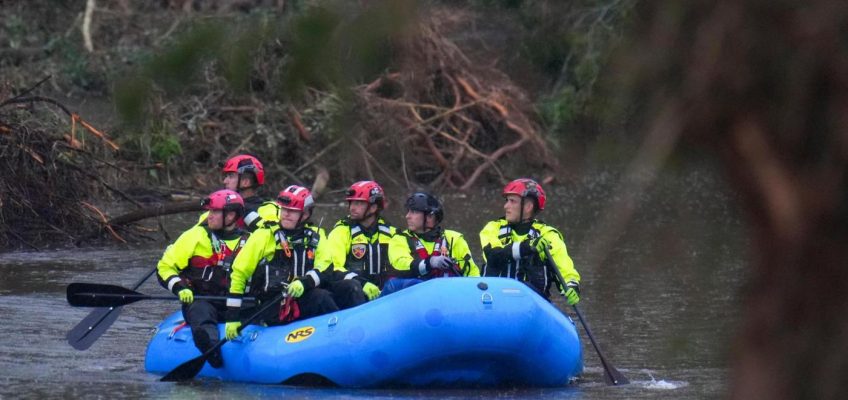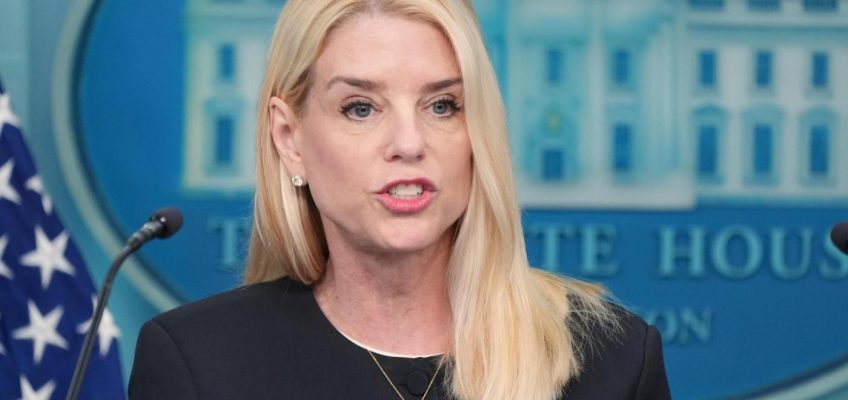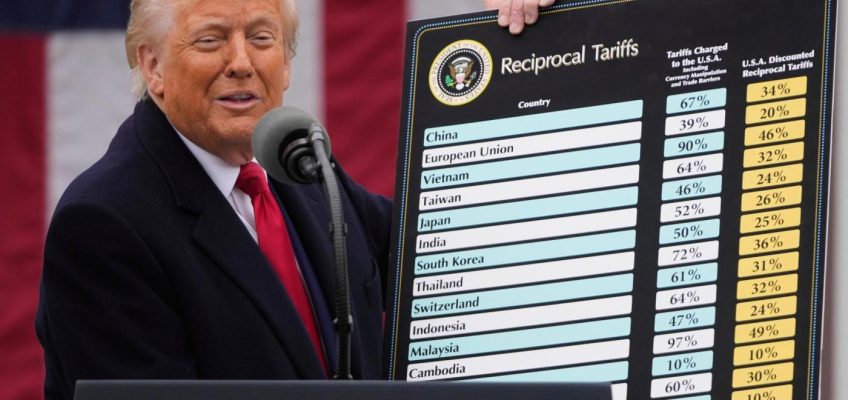By MICHAEL BIESECKER and BRIAN SLODYSKO
WASHINGTON (AP) — Former federal officials and outside experts have warned for months that President Donald Trump’s deep staffing cuts to the National Weather Service could endanger lives.
After torrential rains and flash flooding struck Friday in the Texas Hill Country, the weather service came under fire from local officials who criticized what they described as inadequate forecasts, though most in the Republican-controlled state stopped sort of blaming Trump’s cuts. Democrats, meanwhile, wasted little time in linking the staff reductions to the disaster, which is being blamed for the deaths of at least 80 people, including more than two dozen girls and counselors attending a summer camp on the banks of the Guadalupe River.
The NWS office responsible for that region had five staffers on duty as thunderstorms formed over Texas Thursday evening, the usual number for an overnight shift when severe weather is expected. Current and former NWS officials defended the agency, pointing to urgent flash flood warnings issued in the pre-dawn hours before the river rose.
“This was an exceptional service to come out first with the catastrophic flash flood warning and this shows the awareness of the meteorologists on shift at the NWS office,” said Brian LaMarre, who retired at the end of April as the meteorologist-in-charge of the NWS forecast office in Tampa, Florida. ″There is always the challenge of pinpointing extreme values, however, the fact the catastrophic warning was issued first showed the level of urgency.”
Questions linger about level of coordination
Questions remain, however, about the level of coordination and communication between NWS and local officials on the night of the disaster. The Trump administration has cut hundreds of jobs at NWS, with staffing down by at least 20% at nearly half of the 122 NWS field offices nationally and at least a half dozen no longer staffed 24 hours a day. Hundreds more experienced forecasters and senior managers were encouraged to retire early.
The White House also has proposed slashing its parent agency’s budget by 27% and eliminating federal research centers focused on studying the world’s weather, climate and oceans.
The website for the NWS office for Austin/San Antonio, which covers the region that includes hard-hit Kerr County, shows six of 27 positions are listed as vacant. The vacancies include a key manager responsible for issuing warnings and coordinating with local emergency management officials. An online resume for the employee who last held the job showed he left in April after more than 17 years, shortly after mass emails sent to employees urging them to retire early or face potential layoffs.
Democrats on Monday pressed the Trump administration for details about the cuts. Senate Minority Leader Chuck Schumer demanded that the administration conduct an inquiry into whether staffing shortages contributed to “the catastrophic loss of life” in Texas.
Meanwhile, Trump said the job eliminations did not hamper any weather forecasting. The raging waters, he said Sunday, were “a thing that happened in seconds. No one expected it. Nobody saw it.”
Former officials warn that job cuts could hamper future forecasts
Former federal officials and experts have said Trump’s indiscriminate job reductions at NWS and other weather-related agencies will result in brain drain that imperils the federal government’s ability to issue timely and accurate forecasts. Such predictions can save lives, particularly for those in the path of quick-moving storms.
“This situation is getting to the point where something could break,” said Louis Uccellini, a meteorologist who served as NWS director under three presidents, including during Trump’s first term. “The people are being tired out, working through the night and then being there during the day because the next shift is short staffed. Anything like that could create a situation in which important elements of forecasts and warnings are missed.”
After returning to office in January, Trump issued a series of executive orders empowering the Department of Government Efficiency, initially led by mega-billionaire Elon Musk, to enact sweeping staff reductions and cancel contracts at federal agencies, bypassing significant Congressional oversight.
Though Musk has now departed Washington and had a very public falling out with Trump, DOGE staffers he hired and the cuts he sought have largely remained, upending the lives of tens of thousands of federal employees.
Cuts resulted from Republican effort to privatize duties of weather agencies
The cuts follow a decade-long Republican effort to dismantle and privatize many of the duties of National Oceanic and Atmospheric Administration, the agency within the Commerce Department that includes the NWS. The reductions have come as Trump has handed top public posts to officials with ties to private companies that stand to profit from hobbling the taxpayer-funded system for predicting the weather.
Project 2025, the conservative governing blueprint that Trump distanced himself from during the 2024 campaign but that he has broadly moved to enact once in office, calls for dismantling NOAA and further commercializing the weather service.
Chronic staffing shortages have led a handful of offices to curtail the frequency of regional forecasts and weather balloon launches needed to collect atmospheric data. In April, the weather service abruptly ended translations of its forecasts and emergency alerts into languages other than English, including Spanish. The service was soon reinstated after public outcry.
Related Articles
Deals made by Trump since pausing his ‘Liberation Day’ tariffs remain sparse
Trump to put 25% tariffs on allies Japan and South Korea
Trump administration’s crackdown on pro-Palestinian campus activists faces federal trial
Trump and Netanyahu may take a victory lap on Iran, but the Gaza war looms over their meeting
Pressure from Trump for trade deals before Wednesday deadline, but hints of more time for talks
NOAA’s main satellite operations center briefly appeared earlier this year on a list of surplus government real estate set to be sold. Trump’s proposed budget also seeks to shutter key facilities for tracking climate change. The proposed cuts include the observatory atop the Mauna Loa volcano in Hawaii that for decades has documented the steady rise in plant-warming carbon dioxide in the Earth’s atmosphere from burning fossil fuels.
On June 25, NOAA abruptly announced that the U.S. Department of Defense would no longer process or transmit data from three weather satellites experts said are crucial to accurately predicting the path and strength of hurricanes at sea.
“Removing data from the defense satellite is similar to removing another piece to the public safety puzzle for hurricane intensity forecasting,” said LaMarre, now a private consultant. ”The more pieces removed, the less clear the picture becomes which can reduce the quality of life-saving warnings.”
Trump officials say they didn’t fire meteorologists
At a pair of Congressional hearings last month, Commerce Secretary Howard Lutnick called it “fake news” that the Trump administration had axed any meteorologists, despite detailed reporting from The Associated Press and other media organizations that chronicled the layoffs.
“We are fully staffed with forecasters and scientists,” Lutnick said June 4 before a Senate appropriations subcommittee. “Under no circumstances am I going to let public safety or public forecasting be touched.”
Despite a broad freeze on federal hiring directed by Trump, NOAA announced last month it would seek to fill more than 100 “mission-critical field positions,” as well as plug holes at some regional weather offices by reassigning staff. Those positions have not yet been publicly posted, though a NOAA spokesperson said Sunday they would be soon.
Asked by AP how the NWS could simultaneously be fully staffed and still advertise “mission critical positions” as open, Commerce spokesperson Kristen Eichamer said the “National Hurricane Center is fully staffed to meet this season’s demand, and any recruitment efforts are simply meant to deepen our talent pool.”
“The secretary is committed to providing Americans with the most accurate, up-to-date weather data by ensuring the National Weather Service is fully equipped with the personnel and technology it needs,” Eichamer said. “For the first time, we are integrating technology that’s more accurate and agile than ever before to achieve this goal, and with it the NWS is poised to deliver critical weather information to Americans.”
Uccellini and the four prior NWS directors who served under Democratic and Republican presidents criticized the Trump cuts in an open letter issued in May; they said the administration’s actions resulted in the departures of about 550 employees — an overall reduction of more than 10 percent.
“NWS staff will have an impossible task to continue its current level of services,” they wrote. “Our worst nightmare is that weather forecast offices will be so understaffed that there will be needless loss of life. We know that’s a nightmare shared by those on the forecasting front lines – and by the people who depend on their efforts.”
NOAA’s budget for fiscal year 2024 was just under $6.4 billion, of which less than $1.4 billion went to NWS.
Experts worry about forecasts for hurricanes
While experts say it would be illegal for Trump to eliminate NOAA without Congressional approval, some former federal officials worry the cuts could result in a patchwork system where taxpayers finance the operation of satellites and collection of atmospheric data but are left to pay private services that would issue forecasts and severe weather warnings. That arrangement, critics say, could lead to delays or missed emergency alerts that, in turn, could result in avoidable deaths.
D. James Baker, who served as NOAA’s administrator during the Clinton administration, questioned whether private forecasting companies would provide the public with services that don’t generate profits.
“Would they be interested in serving small communities in Maine, let’s say?” Baker asked. “Is there a business model that gets data to all citizens that need it? Will companies take on legal risks, share information with disaster management agencies, be held accountable as government agencies are? Simply cutting NOAA without identifying how the forecasts will continue to be provided is dangerous.”
Though the National Hurricane Center in Miami has been largely spared staff reductions like those at regional NWS offices, some professionals who depend on federal forecasts and data greeted the June start of the tropical weather season with profound worry.
In an unusual broadcast on June 3, longtime South Florida TV meteorologist John Morales warned his viewers that the Trump administration cuts meant he might not be able to provide as accurate forecasts for hurricanes as he had in years past. He cited staffing shortfalls of between 20% and 40% at NWS offices from Tampa to Key West and urged his NBC 6 audience in greater Miami to call their congressional representatives.
“What we are starting to see is that the quality of the forecasts is becoming degraded,” Morales said. “And we may not know exactly how strong a hurricane is before it reaches the coastline.”




